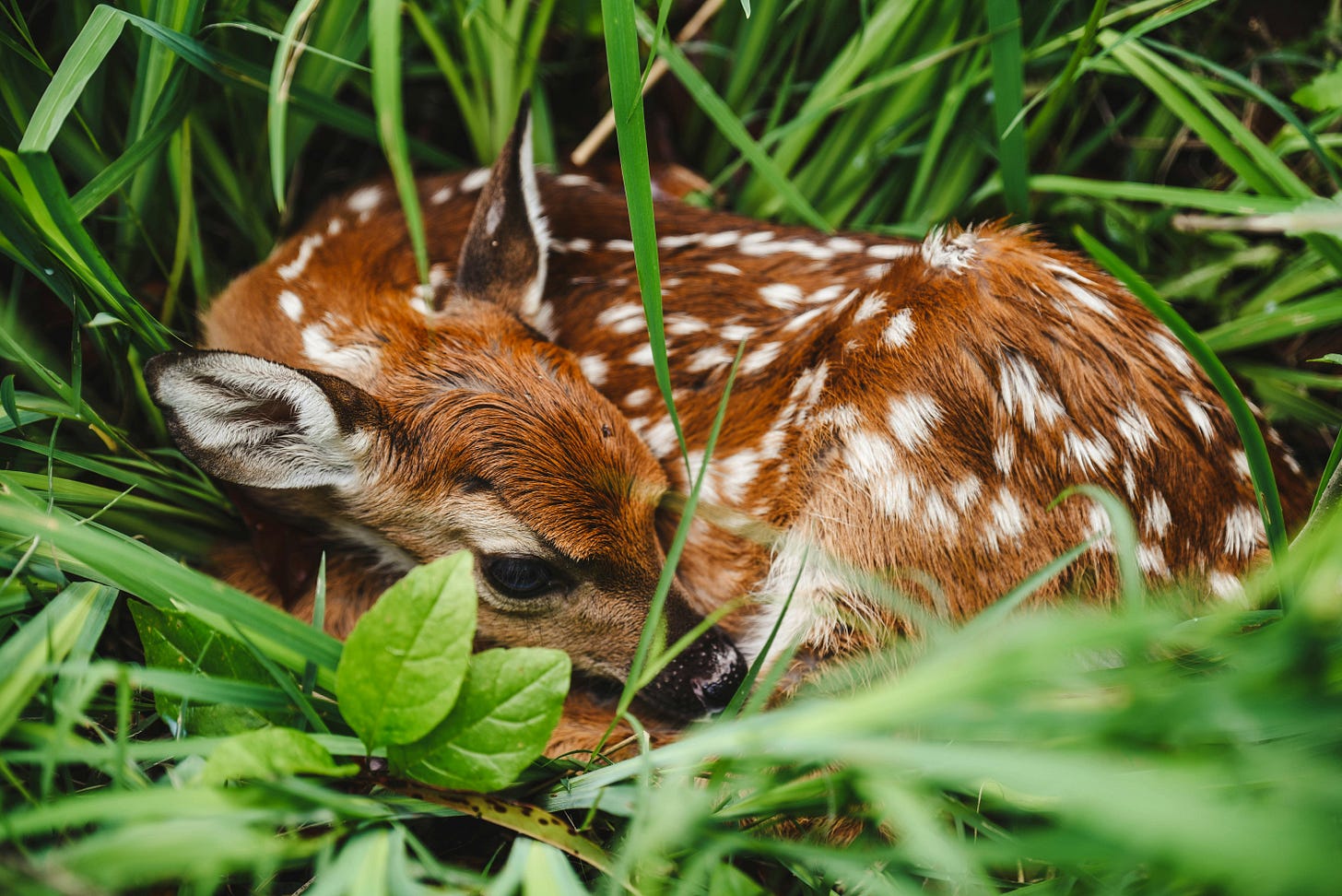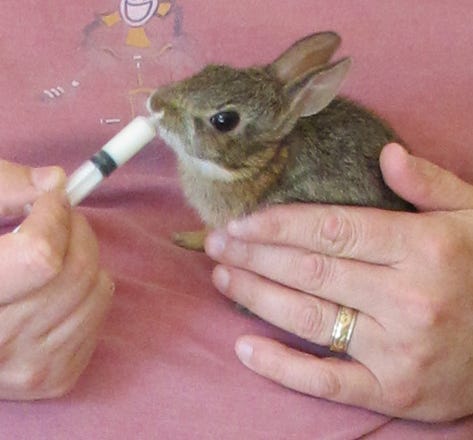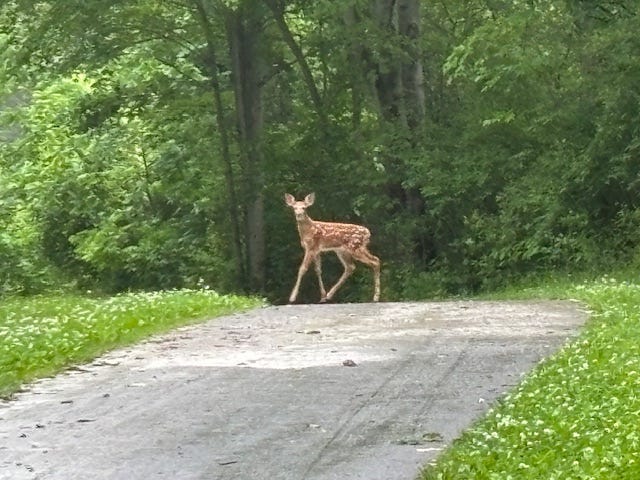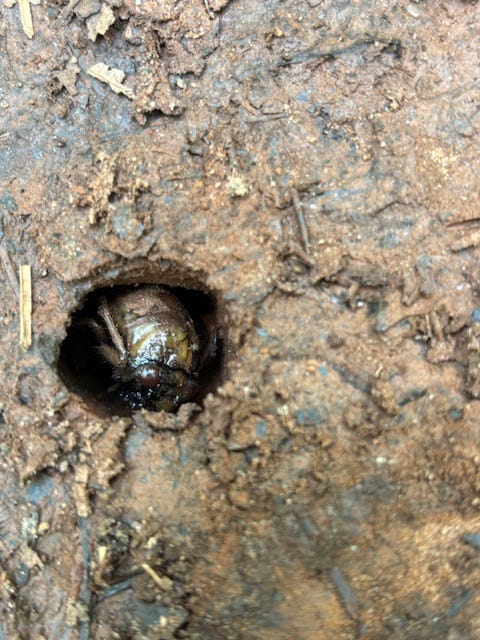
Father’s Day has just passed, which means among other things that mother deer have dropped their fawns, at least here in the southern U.S. It’s a date commonly known by hunters, but I’ll always associate it with a family gathering when, as we congregated on the porch to celebrate Dad, we heard a plaintive bleating sound. Scrambling through the high grass revealed a days-old fawn curled up, weak from hunger. It didn’t take long to piece together that the dead doe on the highway the day before must have been this little one’s mother. The fawn was dehydrated and unable to stand, so we carried it to the porch and called the Department of Natural Resources. Andrew cradled it in his lap and dribbled water into its mouth bit by bit until suddenly the fawn revived, spotted Andrew’s Adam’s apple and attempted to latch on for sustenance. Needless to say, Andrew hasn’t been an enthusiastic deer hunter since.
As I was hiking with a friend the other day, she complained that one of her neighbors, someone newly moved in from the city, found a baby fawn in their field. Thinking it was adorable, she stooped to pet it, not realizing that mothers stash their babies in tall weeds while they wander off to eat. In these early stages, fawns have no scent and thus coyotes and dogs are unable to track them down.
But can they take on human scent if handled? My friend was frustrated that the neighbor had potentially caused the mother deer to abandon her fawn, similar to a baby bird that’s been handled by people. Is that true? Can parents of wild animals smell human scent on their offspring and do they abandon them because of it?
If you touch a young wild animal, will the mother abandon it?
Baby animals are adorable. What we might call the “aw!!” factor has a scientific name – baby schema, coined by Konrad Lorenz, the same zoologist famous for describing imprinting, the tendency of baby birds to attach to the first thing they see upon hatching. Lorenz famously caused goslings to imprint on him and also on moving balls or papier-mâché ducks as well.
Baby schema is what we call the collection of features that help us recognize an animal, including humans, as a helpless juvenile – large head and eyes, chubby cheeks and body, and stubby arms or legs. We have evolved to respond in a caring way to animals with these features.
While human parents won’t mind you cooing and cuddling their cute offspring, baby schema can get us in trouble when it comes to wild animals. Most baby animals that are “rescued” by well-meaning humans were not in danger and should have been left alone.
“If you care, leave it there!” states the New York Department of Environmental Conservation.

However, the idea that touching a baby animal will cause the mother to abandon it is just a myth. Whether it’s a squirrel, bunny, fawn, or baby bird, touching a young animal and leaving your scent is not enough to cause the mother to abandon it (or eat it, which is another myth).
If you find a fawn curled up in a dangerous place like the corner of a dog yard or next to a highway, it is ok to move it carefully to a nearby safe spot where the mother will find it. If it’s a baby bird, you can gently place it back in the nest without fear that the mother will desert it. In general, birds don’t have a great sense of smell and instead recognize their babies like we do – by appearance. Even if you handle a bird’s eggs, the parents won’t stop caring for them.

On the other hand, if the baby is safe where it is, it’s best to leave it alone. Squirrels and rabbits can carry fallen babies back to their nests by the scruff of their necks. Mother deer intentionally stash their babies in hideaway spots so they can go eat in peace, periodically coming back to nurse the fawn. However, they won’t return if people or dogs are nearby.
Another reason mother does leave their fawns unattended for their first few weeks of life has to do with scent. Newborn fawns have very little scent because their scent glands are not fully developed. The mothers stay away for hours at a time in order not to contaminate the area with her scent and potentially attract predators. If you, on the other hand, pick up the fawn or pet it, you will leave a human scent that could make it attractive to predators such as foxes or coyotes.
Once a fawn is 5 days old, it becomes very difficult for a human to catch. After it’s 10 days old, it’s virtually impossible. If you’re able to touch a fawn, it’s likely very weak or only a few days old. Baby birds on the ground are often fledglings that are learning to fly. If the bird has developed feathers, leave it alone and let it figure out the mechanics of flying. However, if it has fuzz or very few feathers, it may need help getting back in the nest.
About 10 years ago, we discovered our dog in the yard obsessively licking a baby squirrel that had fallen from its nest. At the time, we thought the dog’s scent would cause the mother to abandon it, so we unsuccessfully tried to nurse it back to health (it may have had internal injuries from the 30+ foot fall). We were more successful with a baby rabbit that had rolled out of its nest high on an embankment and into our yard. The bunny still hadn’t opened its eyes, so Andrew nursed it back to health with kitten formula and a syringe. It became known as Andrew’s BFF (Bunny Foo Foo) and was successfully released back into the wild.


But now I know that mother rabbits can rescue their very young babies, I’d probably do this differently by giving the mother a chance to rescue the baby (which is actually called a “kitten”) herself.
Too often, well-meaning humans get in the way of natural processes. Bottom line: if the animal isn’t injured or in danger, let it be. Which can be hard for us kindhearted humans…







With respect to the mystery animal discovered during trail work, my guess is that it is a cicada nymph. Since it was near the surface, it was probably ready to emerge. Here's an image: https://bugguide.net/images/cache/3H6/HLR/3H6HLREHTHIL2Z0LAZ0L8ZZLPZQLCH8HPZKL4ZHLUZEHNZ9HUZ5LRR5LBZNHAZ8LBZ8LFH8L1ZGLYHMLBZ7LHRUHDH8H.jpg